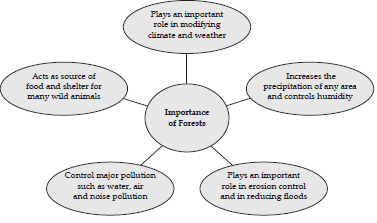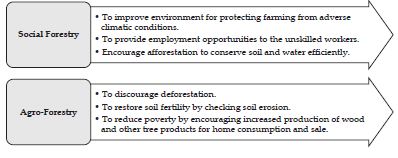Students should refer to Natural Vegetation ICSE Class 10 Geography notes provided below designed based on the latest syllabus and examination pattern issued by ICSE. These revision notes are really useful and will help you to learn all the important and difficult topics. These notes will also be very useful if you use them to revise just before your Geography Exams. Refer to more ICSE Class 10 Geography Notes for better preparation.
ICSE Class 10 Geography Natural Vegetation Revision Notes
Students can refer to the quick revision notes prepared for Chapter Natural Vegetation in Class 10 ICSE. These notes will be really helpful for the students giving the Geography exam in ICSE Class 10. Our teachers have prepared these concept notes based on the latest ICSE syllabus and ICSE books issued for the current academic year. Please refer to Chapter wise notes for ICSE Class 10 Geography provided on our website.
Natural Vegetation ICSE Class 10 Geography
Natural Vegetation ICSE Class 10 Geography Notes
TOPIC-1
Importance of Forests
Quick Review
➢Natural Vegetation refers to the plant cover that has not been disturbed over a long time and has grown naturally depending upon the climate and soil conditions of that area.
➢Grasses, shrubs and trees constitute the natural vegetation of an area.
➢Flora refers to plants of a particular region or period, listed a species, e.g. 4000 species of plants in the Eastern Himalayas.
➢Vegetation refers to the plants and other flora that make up the plant life in the region.
➢It is an assemblage of plant species living in association with each other in a given environmental set-up.
➢Forest is defined as an ecosystem or assemblage of ecosystems dominated by trees and other woody vegetation.
➢It also refers to a large tract of land covered with trees and accompanying undergrowth of shrubs, herbs and sustaining thousands of life forms.
➢In our day to day life, forests play an important role. They are as follows:
(i) Forests are highly productive since they provide us fruits, leaves, roots, tuber of plants, woods for furniture, wood pulp for manufacturing paper.
(ii) The forest animals provide food in the form of meat to the tribals living in the forest.
(iii) Forests also provide essential products like oils seeds, edible plants, fibres, etc.
(iv) Bamboos in the forests also provide as a means of livelihood to the tribal people as they make mats, ropes baskets, etc. from these bamboos.
(v) The forests protect from flooding by controlling the flow of water and prevent evaporation of water due to thick layer of humus.
(vi) The roots of trees in the forest bind the soil firmly which prevents soil erosion.
(vii) The trees absorb the carbon dioxide and releases oxygen which is used by human beings and animals.
(viii) The trees also help in regulating the water cycle.
(ix) The forests provide an abode for the wild animals.
(x) It also provides recreation to humans through various Wildlife Sanctuaries, National Parks, etc.
➢ India can be divided into five major vegetation regions. They are-
(i) Tropical Evergreen
(ii) Tropical Deciduous
(iii) Tropical Desert
(iv) Littoral
(v) Montane
➢ Tropical Evergreen or Rain Forests :
(i) Temperature between 25°C and 27°C.
(ii) Amount of rainfall is more than 200 cm.
(iii) Found in the western slopes of the Western Ghats, hills of north-eastern region and in the island groups of Lakshadweep, the Andaman and Nicobar and Tamil Nadu coasts.
(iv) The characteristic features are :
1. They are dense and have a variety of trees and shrubs.
2. Trees reach at a height of 60 m or above.
3. Due to thick canopy of trees, herbs and grasses cannot grow.
4. These forests do not have any fixed period of time for shedding of leave.
(v) The main varieties of trees are Ebony, Rosewood, Mahogany, Toon, Chaplas, Gurjan, Sissoo, Telsur, etc.
(vi) Economically, these forests were of high value as the timbers produced were hard, durable and fine-grained.
➢ Tropical Deciduous Forests or Monsoon Forests :
➢ On the basis of the availability of the water, these forests were categorized into two types :
(i) The Moist Deciduous Forests
(ii) The Dry Deciduous Forests
The Moist Deciduous Forests :
(i) Rainfall between 100 cm to 200 cm.
(ii) Temperature between 24°C and 27°C.
(iii) Found in the areas of the north-eastern part of the Peninsula, along the foothills of Himalayas, Jharkhand, West Odisha, Chhattisgarh and the eastern slopes of the Western Ghats.
(iv) The main characteristic features are :
1. The trees shed their leaves from six to eight weeks during spring and early summer.
2. These forests are the most commercially exploited forests in India.
3. These forests have trees found in pure stands.
4. They provide valuable timber and other forest products.
(v) The main varieties of tress found here are Sal, Teak, Arjun, Mahua, Shisham, Palas, Mulberry, Semul and Sandalwood.
(vi) These forests are commercially the most exploited one as they provide valuable timber, other forest products like Sandalwood.
➢ The Dry Deciduous Forests :
(i) Rainfall between 70 cm to 100 cm.
(ii) Annual Temperature is between 23°C and 27°C.
(iii) Found in the areas from the foothills of the Himalayas to Kanyakumari except Rajasthan, West Bengal and Western Ghats.
(iv) The main characteristic features are :
1. These forests survive in accordance with the climatic condition of that particular region.
2. The forests on the wetter regions are moist deciduous while on the drier areas, they are thorny bushes.
3. Teak and other trees are spread out in the northern part of India and in the region of higher rainfall in the Peninsular Plateau along with patches of grass.
4. The trees of these forests completely shed their leaves and look like a vast tract of grasslands.
(v) The main trees found there are- Teak, Sal, Tendu, Amaltas, Rosewood, Bel, Khair, etc.
(vi) These forests provide timber, fruits and other valuable products. Parts of these forests are also cleared to carry agricultural activities.
➢ Tropical Desert Forests :
(i) Rainfall is less than 50 cm.
(ii) Temperature between 25°C and 27°C.
(iii) Forests are found in Haryana, South-western Punjab, Uttar Pradesh, Central and Eastern Rajasthan, Chhattisgarh, Gujarat, Madhya Pradesh, parts of Maharashtra, Karnataka and Andhra Pradesh.
(iv) The main characteristic features are :
1. Due to scanty rainfall, the forests have xerophytic vegetation.
2. The trees of the forests are stunted and have large patches of coarse grasses.
3. The trees of these forests remain leafless.
4. The forest looks like scrub vegetation.
(v) The important trees of these forests are Date Palm, Khair, Ber, Babool, Neem, Kanju, Kejri, Cactil, etc.
(vi) The trees are economically valuable. The Ber fruit is useful for making pickle or beverage and is also eaten raw, timber is hard and durable, Date Palm is eaten raw and is used as an astringent, as a decoction, etc. Neem leaves and its bark are used for making many health related and beauty products.
➢ Littoral or Mangrove Tidal Forests :
(i) These forests are grown along the sea coasts, in wet marshy areas, in river deltas, in tidal or other swampy areas.
(ii) Found in the areas around the deltas of the large rivers along the eastern coasts, in the saline swamps of Sunderbans in West Bengal, along the coasts of Odisha and Andhra Pradesh.
(iii) The main characteristic features are :
1. These forests are dense, evergreen and of varying heights.
2. The trees have long roots submerged under water and have pores which help them to breathe during high tide.
3. The tidal tree yields hardwood which is strong and durable and is used for making boats and boxes.
4. The most important tree is the Sundari tree in the Ganga Delta from which the word Sunderbans is coined.
5. The Indian tidal or mangrove forests are considered as the largest mangrove forest in the world.
6. These mangrove forests are one of the most productive and bio-diverse wetlands on earth.
7. These forests have nicely adapted to the muddy, shifting, saline conditions and grow in the brackish marshy areas, mud flats and estuaries along the coast.
(iv) The important trees are the Sundari, Gorjan, Hintal, Keora, Rhizophora, Amur, Bhara, Canes, etc.
(v) The Littoral forests are economically important too. The Mangrove trees are utilised for fuel while the Sundari trees provide hard, durable timber and is used for making boats and boxes.
➢ Montane Forests :
(i) Rainfall between 100 and 300 cms.
(ii) Temperature between 12°C and 13°C and the humidity is between 56%-65%.
(iii) These forests are found in the mountain regions having an altitude between 1000 m to 4000 m.
(iv) The main characteristic features are :
1. These forests are mainly found in the higher hills of Tamil Nadu and Kerala, in the Eastern Himalayan region including the hills of West Bengal, Assam, Arunachal Pradesh, Sikkim and Nagaland.
2. These forests are evergreen forests in which the trees are mostly branchy, leaves are broad, dense and rounded.
3. The branches are covered with mosses, lichens, ferns and creepers.
4. It provides fine wood which is of much use for construction, timber and railway sleepers.
5. These forests occur in the temperate zone of the Himalayas at an altitude between 1500 and 3300 metres where the annual rainfall varies from 150 cm to 250 cm.
6. The Himalayan moist temperate forests cover the entire mountain range in Kashmir, Himachal Pradesh, Uttarakhand, Darjeeling and Sikkim.
7. In the Peninsular region, these forests are found at an altitude of 1500 m.
(v) The important trees of the Montane forests are Indian Chestnut, Birch, Plum, Cinchona, Litsea, Mangolia,Pine, Oak, Hemlock, etc.
➢ Important Trees and their Uses
(i) Ebony : It is used for ornamental carving, making musical instruments, sports goods, piano keys etc.
(ii) Rosewood : It is used for making furniture, doors windows, musical instruments, carvings etc. Because of durability it is often used in the martial art weaponry. It is also good for medicinal purposes like it is useful against acne.
(iii) Teak : It has high oil content making it very weather resistant. It has great value as timber and is very heavy, tough and durable. It is broadly used for making furniture, houses and also ships. The bark of the teak tree is considered to be astringent and is used to treat bronchitis.
(iv) Mahogany : It is very durable and is mainly used for crafting cabinets and furniture, musical instruments. It resists wood rot and is used for the construction of boat.
(v) Sal : It is hard, tough and heavy wood. It is mainly used for making doors, windows, railings of bridges, beams, railway sleepers.
(vi) Sandalwood : It is widely used in the cosmetic industry. It is used as perfume and its oil is used in making aromatic substances. It is also used for making ornamental objects like statues.
(vii) Ber : It is hard, tough and durable wood. It is a fruit which is eaten raw as it is rich in Vitamin C and is also used to make pickle or beverage. It is used for making agricultural implements, boat ribs, charcoal, etc.
(viii) Babool : It has high medicinal value. It is a source of gum and used as an emulsifier. The twigs and barks are chewed to prevent Vitamin C deficiency. Its wood is used as fire wood and charcoal and for boat building.
(ix) Palas : It’s leaves are used for rearing shellac worms.
(x) Neem : The leaves, bark and roots of this tree has medicinal properties. It helps to cure skin infection, ulcers, allergies, etc. Its oil is used for manufacturing beauty and health products.
(xi) Cinchona : Cinchona is used for increasing appetite. It is also used for blood vessel disorders including hemorrhoids, varicose veins, and leg cramps. It contains quinine, which is a chemical used to treat malaria. Cinchona bark stimulates saliva and stomach (gastric) juice secretion.
(xi) Deodar : Its wood is strong, durable and tough. It is mainly used for construction and for making railway sleepers.
(xii) Sundari : It is a hard, durable and strong tree. It is mainly used for making boats and for house construction.
Know the terms
➢ Flora : It refers to plants of a particular region or period.
➢ Forest : It is defined as an ecosystem or assemblage of ecosystems dominated by trees and other woody vegetation.
➢ Canopy : The uppermost leafy layer of a forest, formed by the crowns of the trees and climbers.
➢ Decoction : It is a method of extraction by boiling herbal or plant material to dissolve the chemicals of the material, which may include stems, roots, bark and rhizomes.
➢ Mangrove : A mangrove is a shrub or small tree that grows in coastal saline or brackish water.
➢ Montane : It means of or inhabiting mountainous regions.
Flowchart
TOPIC-2
Distribution and Correlation with their Environment
Quick Review
➢India is a vast, diverse country and is one of the seventeen mega bio-diverse regions of the world.
➢From world’s highest rainfall region to dry desert like Thar, from productive Eastern and Western coast line to alpine regions and from river deltas to tropical islands, are found in this land.
➢India has a large variety of forest vegetation and has 600 species of hardwoods like sal, teak, etc.
➢Indian forests types include Tropical Evergreens, Tropical Deciduous, Littoral, Mangroves, Sub-Tropical, Montane, Tropical Desert, Sub-Alpine and Alpine forests.
➢These forests support a variety of ecosystems with diverse flora and fauna.
➢In 1970, India declared three major objectives for forestry development: (i) to reduce soil erosion and flooding, (ii) to supply the growing needs of the domestic wood products industries, and (iii) to supply the needs of the rural population for fuel wood, fodder, small timber, and miscellaneous forest produce.
➢In 1976, the National Commission on Agriculture recommended advocated the concept of social forestry and in 1980 forestry was encouraged by state community forestry agencies.
➢In 2002, India set up a National Forest Commission to review and assess India’s policy and law and its effects on India’s forests.
➢Forests have an interrelationship with environment.
➢Forest plays an important role in modifying climate and weather. It reduces mean annual temperature.
➢It helps in lowering maximum temperature and raises the minimum temperature.
➢Forest increases the precipitation of any area and controls humidity.
➢By reducing surface runoff, the forest vegetation helps to increase the amount of water that percolates into a soil.
➢Forests help in the firmness and stability of the soil by checking the velocity of wind and by reducing surface runoff.
➢Forest plays an important role in erosion control.
➢Forests help in reducing floods in the hilly region as well as in the plains by reducing the volume of surface run-off.
➢Forests have the potential to bring change in the climatic condition of a region through their influence on the global carbon cycle.
➢Trees and other green plants produce oxygen and consume carbon dioxide.
➢Forests also control major pollution such as water, air and noise pollution.
➢It also influences the life of many terrestrial animals.
➢It acts as source of food and shelter for many wild animals.
➢Forests improve the nutrition of soil through the addition of organic matter, decomposition of leaves and penetration of plant root.

Know the terms
➢Bio-Diverse Regions : It refers to areas containing a wide variety of plant and animal species.
➢Ecosystem : It means a community of living organisms together with the non-living components of their environment like air, water and mineral soil, interacting as a system.
➢National Forest Commission : This Commission was set up to review and asses India’s policy and law, its effect on India’s forests and their impact from the ecological, scientific, economic, social and cultural points of view.
➢Global Carbon Cycle : It describes the exchanges of carbon between the earth’s atmosphere, oceans, land and fossil fuels
Flowchart

TOPIC-3
Forest Conservation
Quick Review
➢Man, in order to satisfy his own need, indiscriminately deforested the forested areas which led to a decline in the forest cover area.
➢Some reasons that led to the decline in the forest are :
(i) Increasing population
(ii) Converting forests into pasture lands
(iii) Overgrazing of animals
(iv) Increasing demand for timber
(vi) Construction of multi-purpose river valley projects
➢All these reasons has an adverse effect, like decline in forest productivity, causes soil erosion and floods, reduces rainfall causing droughts and increasing the Green House effect in the atmosphere.
➢In order to conserve forests, many practices have to be undertaken by the people. Some of these practices are :
(i) To plant trees.
(ii) To discourage cutting of trees and ensure to plant ten saplings in lieu of felling one tree.
(iii) Banning the practice of shifting cultivation prevalent amongst the tribals.
(iv) To grow trees around the Iron and Steel industries and other industrial units.
(v) To use non-conventional or renewable sources of energy like solar energy, tidal energy, etc.
(vi) To establish corridors between the forests for the migration of wild animals.
(vii) To make strict conservation measures and laws to check deforestation.
(viii) Participation of people in planning, decision making and implementation of forest programmes.
➢In 1988, the Forest Conservation Act of 1980 was amended to facilitate stricter conservation measures.
➢India launched its National Forest Policy in 1988 and led to a programme named Joint Forest Management.
➢This policy proposed that specific villages in association with the forest department will manage specific forest blocks.
➢The other objectives of this policy are :
(i) Restoration of ecological balance.
(ii) Maintenance of environmental stability.
(iii) Preserving natural forests through wide variety of flora and fauna.
(iv) Checking soil erosion and the extension of sand-dunes in the desert areas.
(v) To increase forest cover area through extensive afforestation and social forestry programmes.
(vi) To meet the basic requirements of the rural and tribal people by providing fuel wood, minor forest product, fodder, etc.
(vii) Encouraging the use of forest produce.
(viii) Organising people’s movement in order to achieve these objectives. Even women are involved, in particular, to be a part of these movements.
➢Social Forestry means the management and protection of forests and afforestation of barren and deforested lands with the purpose of helping in the environmental, social and rural development.
➢It also aims at raising plantations by the common man so as to meet the growing demand for timber, fuel wood, fodder, etc., thereby reducing pressure on traditional forest areas.
➢Since India has dominantly a rural population and largely depends on fuel wood and other biomass for their cooking and heating, the need for a social forestry scheme was felt.
➢Another scheme taken up under the social forestry programme is the raising of trees on community land and not on private land.
➢Social forestry scheme can be categorized into groups; farm forestry, community forestry, extension forestry and agro forestry.
➢The government through these schemes aims at providing an entire community and not an individual and takes the responsibility of providing seedlings and fertilizers provided the community takes the responsibility of saving and protecting the trees.
➢The objectives of social forestry are :
(i) To improve environment for protecting farming from adverse climatic conditions.
(ii) To increase the supply of fuel wood, fodder for livestock, small timber for rural housing, minor forest products for local industries.
(iii) To enhance the natural scenic beauty of the area.
(iv) To provide employment opportunities to the unskilled workers.
(v) To utilize rehabilitated land or restored land for better production.
(vi) To create forests as recreational centres for the people.
(vii) To develop local cottage industries by providing raw materials.
(viii) Encourage afforestation to conserve soil and water efficiently.
(ix) Its mission is to convert urban and industrial areas into Green Belts.
(x) To enhance the quality of life and raise the standard of living of both the urban and the rural population.
➢Agro forestry may be defined as a sustainable land use system that maintains or increases the total yield by combining food crop together with forest tree and livestock ranching on the same unit of land, using management practices that take care of the social and culture characteristic of the local people and the economic and ecological condition of the local area.
➢It is a part of social forestry.
➢In agro forestry growing of forest tree along with agriculture crop on the same piece of land is carried out.
➢It is an intermediate stage between forestry and agriculture.
➢It aims to provide soil conservation to improve the growth of forest products and agricultural crops together.
➢Objectives of Agro Forestry :
(i) To discourage deforestation and reduce pressure on forests for obtaining fuel woods and other forest produce.
(ii) To restore soil fertility by checking soil erosion.
(iii) By proper utilization of farm resources the ecological balance to be maintained.
(iv) To reduce poverty by encouraging increased production of wood and other tree products for home consumption and sale.
Know the terms
➢Multi-Purpose River Valley Projects : It refers to major river valley projects with an aim to meet the basic requirements of irrigation for agriculture, electricity for industries and flood control.
➢Green House Effect : It is a warming of Earth’s surface and the air above it. It is caused by gases in the air that trap energy from the sun. These heat-trapping gases are called greenhouse gases. The most common greenhouse gases are water vapour, carbon-dioxide and methane.
➢Joint Forest Management : It is the official and popular term in India for partnerships in forest movement involving both the state forest departments and local communities.
➢Afforestation : Planting of new trees.
➢Social Forestry : It means the management and protection of forests and afforestation of barren and deforested lands with the purpose of helping in the environmental, social and rural development.
➢Green Belts : It is a policy and land use designation used in land use planning to retain areas of largely undeveloped, wild or agricultural land surrounding or neighbouring urban areas.
➢Agro Forestry : A sustainable land use system that maintains or increases the total yield by combining food crop together with forest tree and livestock ranching on the same unit of land, using management practices that take care of the social and culture characteristic of the local people and the economic and ecological condition of the local area.
Flowchart


We hope you liked Natural Vegetation ICSE Class 10 Geography notes above. If you have any questions please post them in the comments section below and our teachers will provide you a response.


